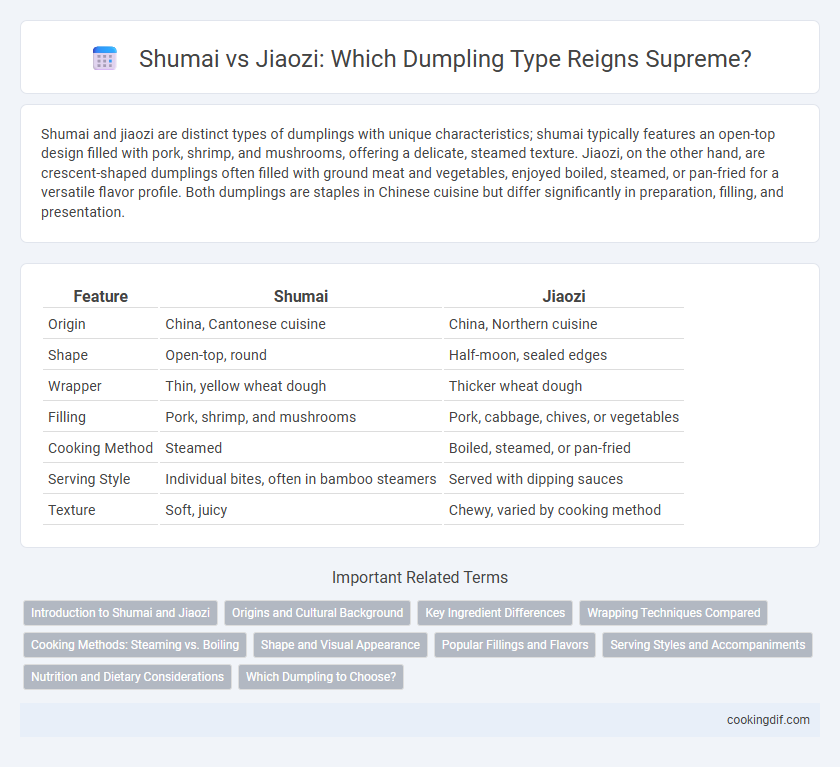Shumai and jiaozi are distinct types of dumplings with unique characteristics; shumai typically features an open-top design filled with pork, shrimp, and mushrooms, offering a delicate, steamed texture. Jiaozi, on the other hand, are crescent-shaped dumplings often filled with ground meat and vegetables, enjoyed boiled, steamed, or pan-fried for a versatile flavor profile. Both dumplings are staples in Chinese cuisine but differ significantly in preparation, filling, and presentation.
Table of Comparison
| Feature | Shumai | Jiaozi |
|---|---|---|
| Origin | China, Cantonese cuisine | China, Northern cuisine |
| Shape | Open-top, round | Half-moon, sealed edges |
| Wrapper | Thin, yellow wheat dough | Thicker wheat dough |
| Filling | Pork, shrimp, and mushrooms | Pork, cabbage, chives, or vegetables |
| Cooking Method | Steamed | Boiled, steamed, or pan-fried |
| Serving Style | Individual bites, often in bamboo steamers | Served with dipping sauces |
| Texture | Soft, juicy | Chewy, varied by cooking method |
Introduction to Shumai and Jiaozi
Shumai and jiaozi are two popular types of Chinese dumplings, each with unique characteristics and cultural significance. Shumai, commonly known as open-topped dumplings, typically feature a thin wrapper filled with a mixture of ground pork, shrimp, and seasonings, often steamed to preserve their delicate texture. Jiaozi, on the other hand, have a crescent-shaped, sealed wrapper filled with ground meat and vegetables, and are usually boiled, steamed, or pan-fried, making them a versatile staple in Chinese cuisine.
Origins and Cultural Background
Shumai originates from Cantonese cuisine and is traditionally a steamed dumpling filled with pork, shrimp, and mushrooms, often served as part of dim sum in southern China. Jiaozi, a staple in northern Chinese cuisine, features a thicker dough wrapper and is typically boiled, steamed, or pan-fried with fillings like ground pork, cabbage, and chives, symbolizing prosperity and family reunions during Chinese New Year. Both dumplings reflect distinct regional flavors and cultural significance, highlighting the diverse culinary history across China.
Key Ingredient Differences
Shumai and jiaozi differ significantly in their key ingredients; shumai typically features a mixture of ground pork, shrimp, and mushrooms wrapped in a thin, yellow wheat wrapper, highlighting a seafood and meat blend. Jiaozi commonly contains ground pork or beef mixed with cabbage, scallions, and ginger, encased in a thicker, white dough wrapper that offers a chewy texture. These ingredient distinctions influence the flavor profiles and cooking methods, with shumai often steamed to preserve its delicate fillings and jiaozi either boiled, steamed, or pan-fried for a versatile taste experience.
Wrapping Techniques Compared
Shumai dumplings feature an open-top wrapping style with thin, delicate wrappers that expose the filling, creating a pleated edge that allows steam to circulate evenly. In contrast, jiaozi dumplings use a thicker, round wrapper sealed tightly by pinching or pleating the edges, ensuring a fully enclosed filling that retains juices during boiling or pan-frying. These distinct wrapping techniques impact texture and cooking methods, with shumai offering a tender bite and jiaozi providing a chewier, more elastic dough experience.
Cooking Methods: Steaming vs. Boiling
Shumai are traditionally steamed, preserving their delicate texture and allowing the flavors of the filling, often pork and shrimp, to remain succulent and juicy. Jiaozi are typically boiled, which results in a tender and slightly chewy wrapper that complements the savory filling's moisture. Steaming shumai emphasizes gentle cooking, while boiling jiaozi promotes even heat distribution and a softer dough consistency.
Shape and Visual Appearance
Shumai dumplings have an open-top, flower-like shape with pleated edges, showcasing fillings like pork or shrimp often topped with roe or peas, creating a colorful and inviting visual. Jiaozi dumplings are crescent-shaped with tightly sealed edges, featuring a smooth, folded surface that highlights a more uniform, pale dough exterior. The distinct shapes and presentation styles of shumai and jiaozi enhance their unique cultural appeal and dining experience.
Popular Fillings and Flavors
Shumai typically features a mixture of ground pork, shrimp, and mushrooms seasoned with soy sauce, sesame oil, and ginger, offering a savory and slightly sweet flavor profile. Jiaozi fillings vary widely but commonly include minced pork, cabbage, garlic chives, and napa cabbage, often enhanced with ginger, soy sauce, and sesame oil for a balanced umami taste. Both dumplings showcase regional ingredients, with shumai's open-top wrapper highlighting its juicy filling and jiaozi's crescent shape enclosing a more varied blend of vegetables and meats.
Serving Styles and Accompaniments
Shumai dumplings are typically served open-faced, showcasing their delicate filling, often accompanied by soy sauce, chili oil, or a tangy vinegar dip to enhance their savory flavor. Jiaozi, on the other hand, are usually sealed and steamed, boiled, or pan-fried, frequently paired with a dipping sauce made from soy sauce, black vinegar, and thinly sliced ginger. Serving styles emphasize texture differences: shumai's tender wrapper contrasts with jiaozi's thicker dough, while accompaniments highlight regional flavor profiles and traditional Chinese dining customs.
Nutrition and Dietary Considerations
Shumai and jiaozi differ significantly in nutritional profiles and dietary considerations, with shumai typically containing a higher fat content due to the use of pork and shrimp fillings combined with a thin wheat wrapper. Jiaozi often includes vegetables such as cabbage and mushrooms, contributing to lower calories and increased fiber, making them suitable for weight management and digestive health. For those monitoring sodium intake or following low-fat diets, steamed jiaozi offers a lighter option, while shumai's richer taste may appeal to those seeking higher protein but should be consumed in moderation.
Which Dumpling to Choose?
Shumai offers an open-topped design with a delicate wrapper and a flavorful filling often made from pork and shrimp, making it ideal for light, bite-sized enjoyment. Jiaozi features a thicker, sealed dough encasing various fillings like pork, cabbage, or vegetables, providing a heartier, more substantial dumpling experience. Choose shumai for a refined appetizer and jiaozi for a filling meal rich in traditional Chinese flavors.
Shumai vs jiaozi for dumpling type Infographic

 cookingdif.com
cookingdif.com